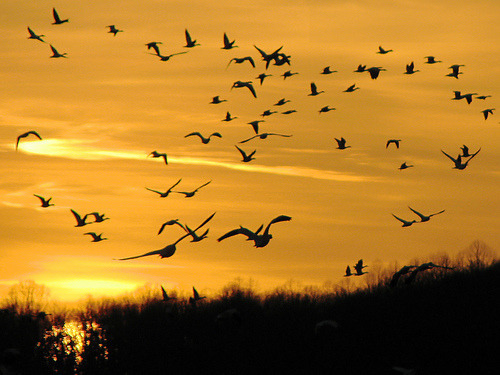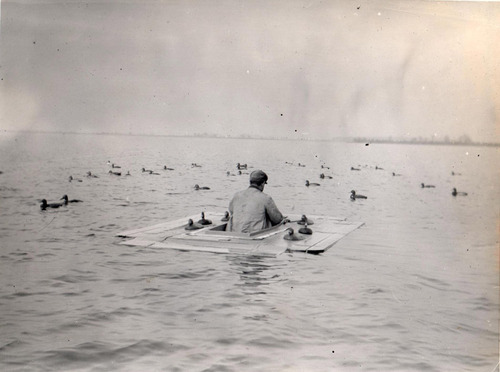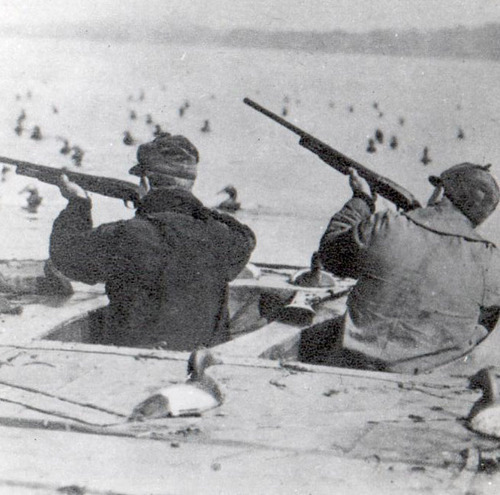Sink, Sank, Sunk
It’s not unusual, this time of year, to wake up to a cool Chesapeake morning that is pealing with the cracks of gunshots. So routine as to be background noise and so seasonal as to be synonymous with heavy frosts and the crimson stars of sweet gum leaves, the gunshots represent one of the great feathered influxes of fall fauna- it’s waterfowl time. For thousands of years, winged visitors from the sloughs of Saskatchewan and even farther north have moved in great v-shaped drifts to the Chesapeake’s verdant waterways as the cold weather descended. And for at least that long, people in the Chesapeake have eagerly anticipated their arrival and the full cookpots and bellies that flying feast represented.

Initially, the populations of the waterfowl that wintered in the Chesapeake were so prodigious that it was almost inconceivable that humans could ever alter the strength of their numbers. Colonist Robert Evelyn, exploring near the head of the Bay in the mid-1600s, saw a flight of ducks and estimated it at a mile across and 7 miles long, with the “rushing and vibration” of their wings sounding like a storm coming through trees. Creative methods were employed by winter hunters for generations to harvest this bounty. In the days predating the Migratory Waterfowl Act of 1918, when limits and regulations were established, gunners could shoot as many waterfowl as they wished, and so many of the early techniques and tools focus on sheer quantity in a way that is foreign to most sport hunters today.

Image from Walsh Collection, Chesapeake Bay Maritime Museum.
One of the most ingenious watercraft designed for market gunning is the sinkbox- a coffin-shaped depression in the water surrounded by a low platform, weighted with lead decoys to float at level with the waterline. Meant to provide camouflage in the wide open waters of the Susquehanna flats, the sinkbox was almost imperceptible from above. Ringed with canvasback and redhead decoys, the sinkbox, with reclining market hunter inside, merged seamlessly with silver water, wispy fog, and grey sky to paint a perfectly Chesapeake (and perfectly deadly) trompe l'oeil. Recounting his days market hunting the Flats in 1878 in Harry Walsh’s The Outlaw Gunner, Bennett Keen recalled, “Our kill out of a sinkbox often ran to well over 100 ducks in a morning… We’d get maybe as much as $1.25 for a pair of canvas and as little as 25 cents for a pair of blackheads.”

Image from Walsh Collection, Chesapeake Bay Maritime Museum.
Hunting transitioned in the late 19th century to include the first generations of recreational gunners. A trend that mirrored the larger national craze for all things outdoors (the Boy Scouts, bicycles, and national parks all had their origins at the tail end of the 1800’s, too), hunting was a way for prosperous, middle and upper-class residents of Philadelphia and Baltimore to spend time along the Chesapeake connecting to their latent survival skills. Under the direction of a skilled guide, weekday office workers in natty new tweeds and stiff oiled canvas would track the canvasbacks waffling in with their shotguns poised, ready to reestablish their position on the top of the food chain with a single shot.

Image from Walsh Collection, Chesapeake Bay Maritime Museum.
Towns with access to the Susquehanna Flat’s superior gunning grounds, like Havre de Grace, swelled with city folk anxious to bag some birds come the opening of hunting season. Sinkboxes were favored above all other methods for their efficiency and success rate- although the sport gunners from out of town were a little soft to stay in them too long, recalled Keen in another excerpt from The Outlaw Gunner: “ For many years I capitalized on the desire of sportmen to shoot the celebrated flats in a sinkbox… I remember once my brother took out Grover Cleveland, and another time J. Pierpont Morgan. The hunters on the boat took turns in the box. If it was very cold they could only take an hour or so of it at a time; then they’d hold up their gun, a signal that they ‘wanted out,’ and to bring another hunter.”

Image from Walsh Collection, Chesapeake Bay Maritime Museum.
The downfall of the sinkbox was the Migratory Waterfowl Act of 1918, which limited hunters to a sustainable, population-protecting rate of a few birds per day- far below the records of 200 to 300 canvasbacks or redheads a day during the height of the market hunting boom. Sinkboxes were notoriously cumbersome to set up- with rigs including hundreds of lead and floating decoys, corn and other bait, and sometimes even live birds to add an element of realism- and for only three or four ducks per day, it was a lot of work for a little reward. By the time they were outlawed in 1935, sinkboxes had already become a rare sight on the wide open water of the Flats- almost as rare as the canvasbacks themselves, which suffered a precipitous decline as their main food, aquatic Bay grasses, were buried under layers of silt as agriculture expanded in the 20th century Chesapeake.
Sinkboxes in the collections of the Upper Bay Museum.
Today, the only sinkboxes that remain are housed in private collections or museums like ours, where they represent the by-gone hunting traditions of the Chesapeake. But on a cold October morning, when the sun slips just over the edge of the horizon and the Chesapeake comes aflame with light, the fusillade of shotgun reports remind us that although the sinkboxes are gone forever, the hunting experience continues as fresh and timely as the day is young.
